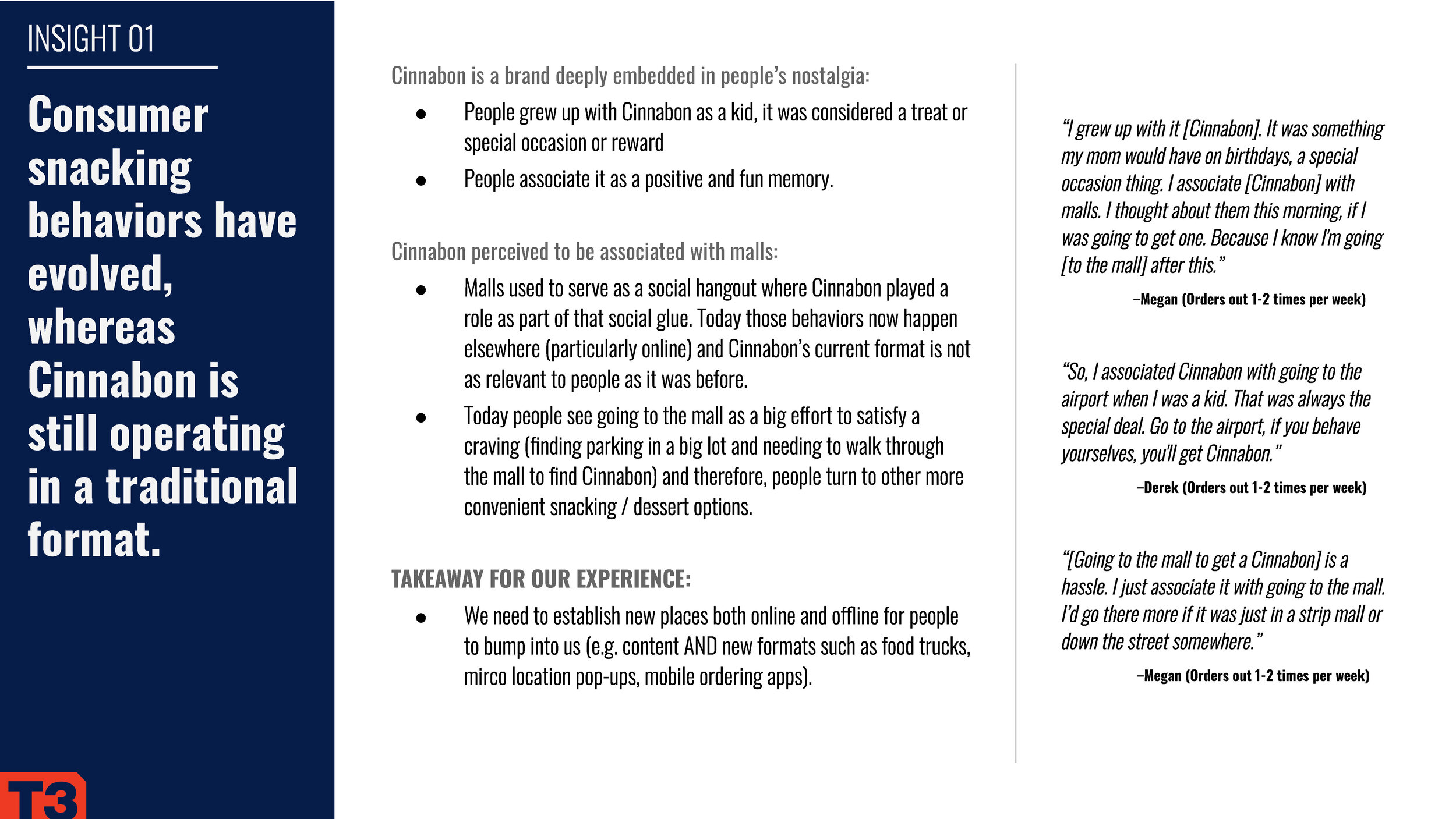Cinnabon
Researching the customer journey for INDULGENT online ordering
EXECUTIVE SUMMARY
With a growing trend of digital restaurant ordering, Cinnabon wanted to see what their customers would expect and demand from them if they were to venture into on-demand delivery or pick-up. Through a week of interviews and two weeks of synthesis, the team developed a set of user mindsets, journeys and design pillars for Cinnabon to follow for service design and planning.
My Role
Associate Director, Experience
Additional Team
Sr. Digital Strategist
Account Director
The problem
Cinnabon wanted to venture into the on-demand delivery market with their products but wanted to reassess their e-commerce ecosystem and be more conducive with consumer needs and expectations.
Process
Over the course of three weeks we would conduct ten in-store intercepts and nine in-home interviews with customers to get a sense of empathy and understanding for their needs when ordering a meal and dessert for delivery or pick-up. After the interviews, we dissected the conversations into affinity diagrams, looking for patterns and slowly defining the users’ needs. The research culminated into two presentations: findings – that defined the user types and outline their needs, and design strategy – that laid out design pillars and provide service design recommendations.
Phase 1: Research & Interviews
Defining the Audience
The team and I worked with the Cinnabon clients to map out the audience to target for the research. We looked at online ordering trends of 2017 and 2018 to see what demographics ordered the most and would drive sales. Our goal was to gain their insight for the best off-premise experience for a Cinnabon delivery service and see if there would be a strong demand for Cinnabon to engage this group. Our target would be 18-35 year olds who have visited a mall and have ordered a meal or dessert (for delivery or pick-up) online or via an app in the last month.
Screener & Discussion Guide
With our audience and research strategy mapped out, I found locations around Chicago to conduct intercepts and I wrote the screener for our user recruiting firm to find the right candidates. Once our list of candidates was compiled, I wrote two discussion guides: the first a intercept interview guide to be completed in five minutes or less, and the second an in-person guide that consisted of a 45 minute interview and ten minutes of card sorting.
Phase 2: Strategy & Vision
Affinity Mapping & Insights
After a week of interviews in Chicago, I started the process of dissecting the conversations, looking for patterns with the help of my Sr. Digital Strategist colleague. Together, we began to see patterns emerge and drew up insights from the transcribed interviews. With those patterns, we found two different user mindsets (spontaneous and planned ordering, respectively) and mapped them into high-level journeys that would inform our design vision.
Our final “Insights” presentation (see below) would help the client better understand the customer demand and expectations of an excellent product delivered to their door.





Strategy and vision
Having the insights mapped out and mindsets defined, the team determined how they could be applied to the business of Cinnabon. Through some ideation/brainstorming sessions, we developed our user modes with more refined user journeys, high-level needs and design pillars for any future service design initiatives. You can see some of this vision in the gallery below.
![Cinnabon Ecomm v2 [27439-1]_Page_10.jpg](https://images.squarespace-cdn.com/content/v1/579687fdd482e9b79a4e95e1/1574136750715-3Z3OXJU8XF62SSFO3QSX/Cinnabon+Ecomm+v2+%5B27439-1%5D_Page_10.jpg)
![Cinnabon Ecomm v2 [27439-1]_Page_11.png](https://images.squarespace-cdn.com/content/v1/579687fdd482e9b79a4e95e1/1574136750470-Z8LE9KOPOIIZSDDTFGRK/Cinnabon+Ecomm+v2+%5B27439-1%5D_Page_11.png)
![Cinnabon Ecomm v2 [27439-1]_Page_12.jpg](https://images.squarespace-cdn.com/content/v1/579687fdd482e9b79a4e95e1/1574136774832-XE5B4FSXQPC4ISVVL0AO/Cinnabon+Ecomm+v2+%5B27439-1%5D_Page_12.jpg)
![Cinnabon Ecomm v2 [27439-1]_Page_13.png](https://images.squarespace-cdn.com/content/v1/579687fdd482e9b79a4e95e1/1574136774497-LYQYO96GB1U837I19CWD/Cinnabon+Ecomm+v2+%5B27439-1%5D_Page_13.png)
![Cinnabon Ecomm v2 [27439-1]_Page_16.jpg](https://images.squarespace-cdn.com/content/v1/579687fdd482e9b79a4e95e1/1574136782474-4Y00VK3FT1SFTIXCHCCA/Cinnabon+Ecomm+v2+%5B27439-1%5D_Page_16.jpg)
![Cinnabon Ecomm v2 [27439-1]_Page_19.jpg](https://images.squarespace-cdn.com/content/v1/579687fdd482e9b79a4e95e1/1574136796195-4J950XEEXQ4ZAC8308KF/Cinnabon+Ecomm+v2+%5B27439-1%5D_Page_19.jpg)
![Cinnabon Ecomm v2 [27439-1]_Page_20.jpg](https://images.squarespace-cdn.com/content/v1/579687fdd482e9b79a4e95e1/1574136796251-ZIMQ3TX17PGCL5KKL0AC/Cinnabon+Ecomm+v2+%5B27439-1%5D_Page_20.jpg)
Outcome
We received great insight from customers from a solid research plan, a well written discussion guide, excellent participants and collaboration between disciplines to create some customer mindsets, journeys and design recommendations. The client was very pleased with the outcome and said how it helped them to better understand the customer demand and expectation from Cinnabon.
What I learned the most
I like talking to people about anything
In the past, I usually worked with or oversaw a team of design researchers. So the opportunity to be this hands-on in research was a great experience. I realized that I like talking to people and I am able to develop a rapport with interview candidates quickly through some light upfront conversation. Having those conversations first-hand was also a great way to be immersed into their needs and allowed me to empathize with them deeper throughout the project.